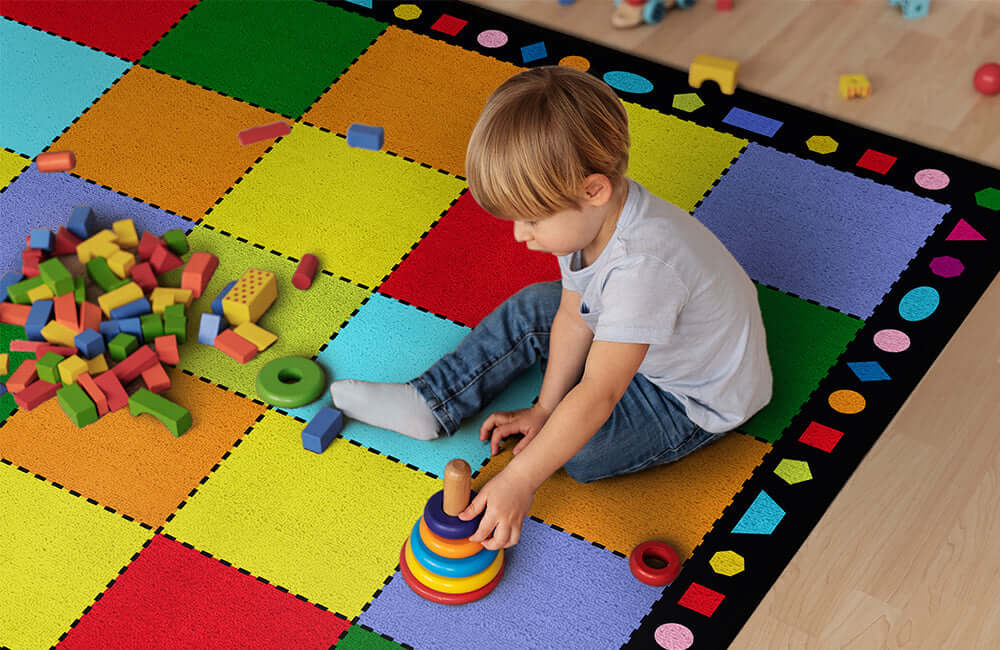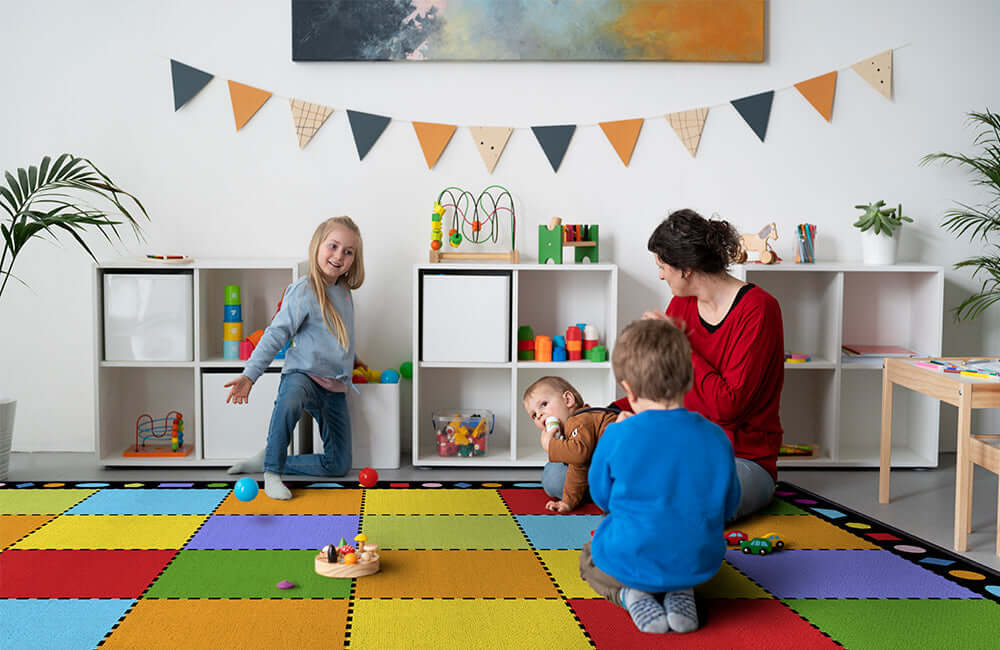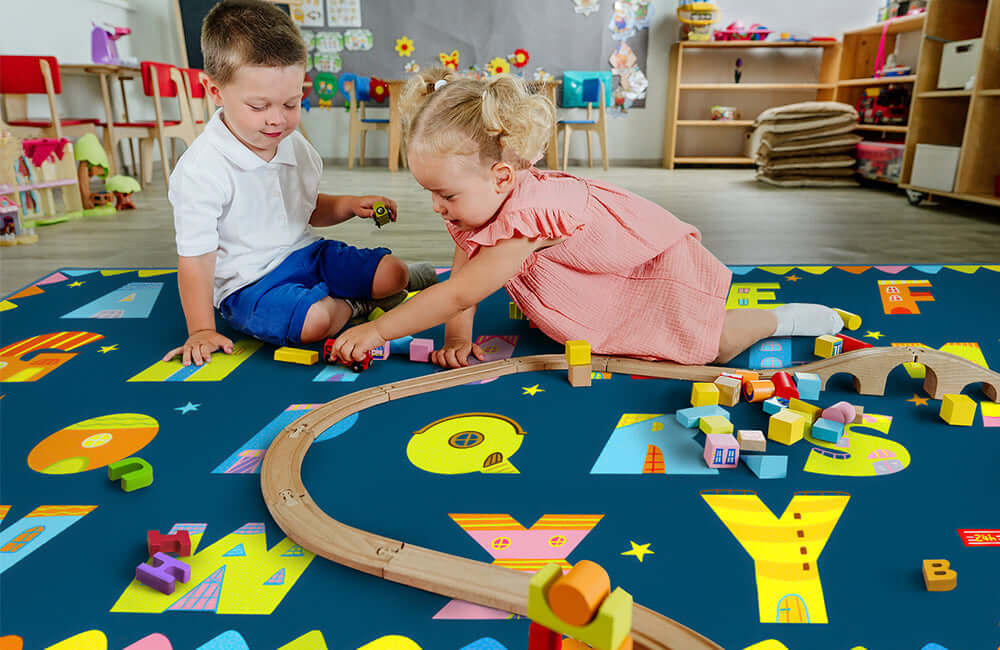The moment a student steps into a classroom, they begin processing visual information that shapes their learning experience—often subconsciously. Among the most powerful yet frequently overlooked elements influencing this experience is color. As educational environments evolve to incorporate more research-based design principles, the strategic use of color through classroom elements like rugs has emerged as a valuable tool for enhancing student engagement, emotional regulation, and cognitive development.
Classroom rugs, with their large surface area and central placement, represent a perfect opportunity to introduce purposeful color into learning spaces. Beyond their practical functions of defining space and absorbing sound, these vibrant floor coverings create psychological and physiological responses that can be harnessed to support educational goals. From stimulating creativity with warm tones to fostering concentration with cool hues, the colors beneath students' feet may be quietly shaping their learning capacity every day.
The Science Behind Color Psychology
Color psychology—the study of how colors affect human behavior and emotional states—has deep roots in both art and science. According to the American Psychological Association, our responses to color derive from both biological reactions and cultural associations, creating patterns of response that educators can leverage.
The biological basis for color's impact starts in the brain. When light of different wavelengths enters our eyes, it triggers hormone production that affects everything from mood to alertness. As explained in Wikipedia's article on color psychology, these reactions can be measured through changes in blood pressure, brain activity, and stress hormone levels.
Research from the field of environmental psychology confirms that color influences cognitive performance. Studies cited by the Journal of Cognitive Research indicate that exposure to different colors can:
- Alter perceived time passage
- Affect reading comprehension
- Influence problem-solving approaches
- Impact memory retention
- Shift creative thinking patterns
These effects aren't limited to conscious awareness—even young children who cannot articulate why they feel more energized or calmer in differently colored spaces still experience these physiological responses.
Key Colors and Their Effects on Learning
Blue: The Concentration Enhancer
Blue tones are associated with:
- Improved focus and concentration
- Lower heart rates and reduced anxiety
- Enhanced productivity for analytical tasks
- Perception of time passing more quickly
Classroom application: Blue rugs work particularly well in reading corners, testing areas, and spaces dedicated to complex problem-solving activities.
Green: The Balance Creator
Green colors provide:
- Enhanced reading speed and comprehension
- Reduced eye strain during extended visual tasks
- Associations with growth, renewal, and nature
- Balance between stimulation and relaxation
Classroom application: Green rugs excel in general classroom areas that serve multiple purposes throughout the day, creating a versatile foundation.
Yellow: The Energy Amplifier
Yellow introduces:
- Increased alertness and attention
- Enhanced memory function for certain tasks
- Higher energy levels and optimism
- Greater expressiveness and communication
Classroom application: Yellow rugs work well in morning meeting areas, collaborative spaces, and zones designated for brainstorming activities.
Red: The Attention Director
Red generates:
- Heightened alertness and excitement
- Increased heart rate and energy
- Potential for both enhanced performance and overstimulation
- Strong emotional responses
Classroom application: Red accents (rather than full rugs) can draw attention to important areas or be used temporarily for high-energy activities.
Purple: The Creative Catalyst
Purple tends to:
- Stimulate imagination and creative thinking
- Create associations with reflection and mindfulness
- Combine the alertness of red with the calmness of blue
- Appeal to artistic sensibilities
Classroom application: Purple rugs work well in art areas, creative writing stations, and spaces designated for imaginative play.
Orange: The Social Stimulator
Orange encourages:
- Social interaction and communication
- Comfort and reduced anxiety in some contexts
- Increased appetite (physical and intellectual)
- Energetic but less intense reactions than red
Classroom application: Orange rugs support small group work, discussion areas, and community-building spaces.
Strategic Color Implementation with Classroom Rugs
The large surface area of classroom rugs makes them ideal vehicles for strategic color implementation. Consider these approaches:
Zone-Based Color Coding
Different-colored rugs can create visual cues about behavioral expectations and activities:
- Cool blue rugs in quiet reading areas
- Energetic yellow or orange rugs in collaborative spaces
- Calming green rugs in general instruction areas
- Creative purple rugs in art and expression zones
Seasonal Color Rotation
Some educators find success rotating rug colors seasonally to:
- Counterbalance natural light conditions (warmer colors during darker winter months)
- Refresh the environment periodically to maintain novelty
- Align with seasonal curriculum themes
- Address changing energy levels throughout the school year
Color Layering
As noted by classroom design expert Maria Chen on Educational Spaces Today, "Effective color implementation rarely means a single dominant hue, but rather thoughtful layering that creates both stimulation and balance." Consider:
- Base rugs in neutral or cool tones
- Colorful carpet squares or overlaid smaller rugs to create interest
- Portable color elements that can be adjusted as needed
Symbolic Color Use
Colors carry cultural and contextual meanings that can support learning:
- Color-coding that aligns with other classroom systems
- Colors that connect to specific curriculum content (green for plant studies, blue for ocean units)
- Cultural color associations relevant to classroom populations and content
Age-Appropriate Color Considerations
Color impacts students differently depending on their developmental stage. Research from Early Childhood Education Journal suggests these age-appropriate approaches:
Early Childhood (Pre-K to Grade 2)
Young children typically respond well to:
- Primary colors with clear distinction
- Moderate to bright color saturation
- Multiple colors that support color recognition
- Colors paired with distinct patterns and shapes
Rug recommendation: Multicolored designs with defined sections, alphabet or number patterns integrated with purposeful color choices.
Elementary (Grades 3-5)
As students develop more sophisticated responses to environment:
- More nuanced color palettes become appropriate
- Colors can be intentionally used to cue behavior
- Connections between colors and curriculum can be explicit
- Balance between stimulation and focus becomes important
Rug recommendation: Designs that incorporate both vibrant and more subdued areas, allowing for different types of activities and energy levels.
Secondary (Grades 6-12)
Older students benefit from:
- More sophisticated color combinations
- Less childlike but still intentional color use
- Colors that acknowledge their age and maturity
- Environments that help regulate varying energy levels
Rug recommendation: More mature patterns with purposeful color zones, potentially including geometric designs that incorporate color psychology principles.
Supporting Different Learning Styles Through Color
Different learners respond to colors in ways that align with their predominant learning styles:
Visual Learners
- Benefit from distinct color coding systems
- May be more sensitive to color's emotional impacts
- Often respond strongly to color-based organizational systems
- Can use color as a memory aid
Classroom application: Clearly defined color zones on rugs that help organize both physical space and conceptual content.
Kinesthetic Learners
- Respond to the movement opportunities different rug areas provide
- Benefit from color cues that designate movement versus sitting spaces
- May need both high-energy and calming color zones
- Connect physical locations with learning content through color association
Classroom application: Activity-zone rugs with color-specific areas for different types of physical engagement.
Auditory Learners
- May benefit from acoustic properties certain rug types provide
- Often respond to color environments that minimize visual distraction
- Can associate discussion areas with specific rug colors
- May need calming colors to support listening focus
Classroom application: Strategic placement of sound-absorbing rugs in colors that support focused listening without visual overwhelm.
Case Studies: Successful Color Applications
Elementary Reading Intervention Program
An Arizona elementary school redesigned their reading intervention spaces with cool blue rugs and minimal competing colors. According to The Reading Teacher journal, students showed measurably longer focus duration and reported feeling "more peaceful" during intervention sessions. Teachers noted that the color change, combined with adjusted lighting, appeared to reduce the perceived difficulty of challenging reading tasks.
Kindergarten Transition Support
A kindergarten teacher in Minnesota implemented a color-zoned approach using different colored carpet tiles to create a large classroom rug with distinct areas. Morning meeting took place on energizing yellow sections, while the cool blue area was designated for post-recess calming activities. Parent feedback indicated that children were developing "color vocabulary" to express their emotional needs—asking to sit in the "blue quiet spot" when overwhelmed or moving to "yellow spots to wake up my brain."
Middle School Flexible Learning Space
When redesigning a middle school humanities classroom, educators incorporated a large central area rug in teal blue with orange border accents. The complementary color scheme provided both focus (blue) and energy (orange) for discussions. Student surveys revealed that 78% preferred the new color scheme over the previous beige carpeting, citing "better concentration during seminars" and "more interesting discussions" as benefits.
Avoiding Overstimulation: Finding the Right Balance
While strategic color use offers significant benefits, balance is critical to avoid sensory overload. According to sensory integration specialists at The Responsive Classroom, overstimulation from excessive or poorly planned color can create:
- Difficulty maintaining attention on relevant stimuli
- Increased stress responses in sensitive students
- Challenges transitioning between activities
- Competing visual information that impedes learning
Guidelines for avoiding overstimulation include:
The 60-30-10 Rule
- 60% dominant color (often a more neutral or cooler tone)
- 30% secondary color (complementary to the dominant color)
- 10% accent color (for energy and interest)
This approach, applied to rugs and surrounding classroom elements, creates visual harmony while still providing necessary stimulation.
Sensory-Sensitive Considerations
For classrooms serving students with sensory processing differences:
- Consider lower saturation colors that provide benefits without overwhelming
- Create clearly defined sensory retreat spaces with calmer colors
- Use borders to create visual boundaries that help with processing
- Provide options for students to reposition to different color zones based on needs
Pattern and Color Interaction
The combination of pattern and color significantly impacts stimulation level:
- Complex patterns in vibrant colors create maximum stimulation
- Simple patterns in vibrant colors provide energy with more visual rest
- Complex patterns in subtle colors offer interest without overstimulation
- Simple patterns in subtle colors create minimal stimulation for focus
Practical Selection Guidelines for Educators
When selecting colored rugs for educational impact, consider these practical guidelines:
Alignment with Fixed Elements
- Assess existing classroom colors in walls, furniture, and fixtures
- Consider natural light exposure and how it affects color perception
- Account for ceiling height and room size when choosing color intensity
- Plan for color coordination with permanent fixtures
Durability and Color Retention
- Investigate colorfastness ratings for different rug materials
- Consider how specific colors show soiling and wear patterns
- Select stain-resistant options that maintain psychological benefits
- Plan for cleaning requirements of different colored materials
Budget-Conscious Approaches
For limited budgets:
- Prioritize one high-impact colored rug for the main gathering area
- Use smaller, inexpensive colored rugs for specific learning centers
- Consider modular carpet tiles that allow for creative color arrangements
- Explore educational supply grant programs specifically for learning environment improvements
Testing Before Investing
Before making significant color investments:
- Create temporary color zones using inexpensive materials
- Observe student responses to different colors over several days
- Collect feedback about emotional and behavioral impacts
- Document any noticeable changes in engagement or focus
Conclusion
The colors we choose for classroom environments—particularly large surface elements like rugs—are not merely decorative decisions but pedagogical ones. By understanding the psychological and physiological impacts of different colors, educators can strategically create learning spaces that support cognitive development, emotional regulation, and diverse learning needs.
As research in environmental psychology continues to evolve, the evidence for color's impact on learning grows stronger. Vibrant classroom rugs offer a perfect entry point for educators interested in applying these principles—providing substantial color influence while remaining flexible, affordable, and easily adjusted compared to permanent elements like wall paint or furniture.
When selected with intentionality and balanced to avoid overstimulation, colored classroom rugs can become powerful tools in an educator's arsenal—silent but constant contributors to a learning environment where students can focus, create, collaborate, and thrive according to their individual needs and the specific demands of different learning activities.




Leave a comment
This site is protected by hCaptcha and the hCaptcha Privacy Policy and Terms of Service apply.